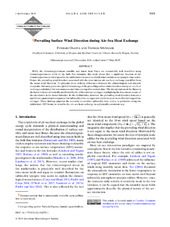Prevailing Surface Wind Direction during Air-Sea Heat Exchange
Peer reviewed, Journal article
Published version

Åpne
Permanent lenke
https://hdl.handle.net/1956/23512Utgivelsesdato
2019Metadata
Vis full innførselSamlinger
- Geophysical Institute [1198]
Originalversjon
https://doi.org/10.1175/jcli-d-18-0752.1Sammendrag
While the climatological-mean sensible and latent heat fluxes are remarkably well described using climatological-mean fields in the bulk flux formulas, this study shows that a significant fraction of the climatological-mean wind speed in the midlatitudes is associated with wind variations on synoptic time scales. Hence, the prevailing wind direction associated with the most intense air–sea heat exchange can differ from the mean wind direction. To pinpoint these striking differences between the climatological and synoptic viewpoint, this study presents a global climatology of the prevailing surface wind direction during air–sea heat exchanges calculated for instantaneous and time-averaged reanalysis data. The interpretation of the fluxes in the lower latitudes is basically unaffected by the different time averages, highlighting the time-mean nature of the circulation in the lower latitudes. In the midlatitudes, however, the prevailing wind direction features a significant equatorward component for subweekly time averages and reverts to pure westerlies for longer time averages. These findings pinpoint the necessity to consider subweekly time scales, in particular along the midlatitude SST fronts, to describe the air–sea heat exchange in a physically consistent way.
